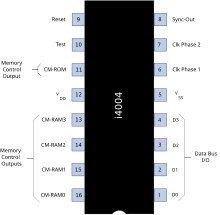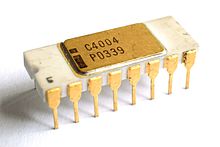Intel 4004
| Intel 4004 >> | |
|---|---|
 Intel C4004 with visible conductor tracks |
|
| Production: | since 1971 |
| Producer: | Intel |
| Processor clock: | 500 kHz to 740 kHz |
| Manufacturing : | 10 µm, PMOS |
| Instruction set : | Intel 4 bit |
| Base: | 16-pin DIP |
The Intel 4004 is a 4- bit - microprocessor of the microchip manufacturer Intel , which was launched on 15 November 1971st It is considered to be the first single-chip microprocessor that was mass-produced and sold on the open market. Usually it is also referred to as the first microprocessor at all, which is not correct, since Texas Instruments developed a microprocessor as a commissioned work as early as 1968, but it never went into series production.
Today the 4004 is one of the most sought-after objects for chip collectors. The rarest is the C4004 in white ceramic with gold cap and visible conductor tracks ("gray traces").
development
The Intel 4004 was commissioned by the Japanese company Busicom in 1969, initially for novel computing machines from Intel, and was operational in 1971. Busicom already had a lot of experience with electronic computers , but was looking for a partner who could integrate the semiconductors even more closely on a chip. At that time, Intel was one of the manufacturers with the greatest available integration density . The first model with an Intel microprocessor was the Busicom 141-PF .
Intel's colleague Ted Hoff formulated the architectural idea in 1969, but did not take part in the development of the first microprocessor. Federico Faggin joined Intel in 1970 from Fairchild (where he developed silicon gate technology , a process technology for MOS field effect transistors with polysilicon gates in 1968 ) to oversee development and design the 4004. Faggin was very familiar with computer architecture, having participated in a project for a small electronic computer at the Olivetti company in 1961 in Italy. At Intel, Faggin developed a new design method using silicon gate technology that was used for the 4004 and other early Intel microprocessors ( 8008 , 4040 , 8080 ). Masatoshi Shima came from Busicom, assisted Faggin during the development of the project and wrote the software for the Busicom Calculator. Faggin founded Zilog , the first company to focus solely on the microprocessor, in 1974 and created the architecture of the Z80 . Shima joined Zilog and developed the Z80 under Faggin's direction.
properties
The design was based on experiences with other CPUs at the time and initially provided for four individual components:
- 4001: a 2048-bit ROM (addressed in 256 8-bit instructions) with a 4-bit output port
- 4002: 80 × 4-bit RAM data memory with a 4-bit I / O port; the RAM area of the chip is organized in four registers of 20 × 4 bits:
- 4003: I / O expansion chip, consisting of a static shift register
- 4004: the actual CPU
Although the data bus of the Intel 4004 was only 4 bits wide, the instruction width was 8 bits. The processor had 16 registers with 4 bits (or 8 with 8 bits) as well as a CALL and a RET command for subroutine calls , with a stack of up to four return addresses.
Intel later bought back the rights to the design of the Intel 4004 from Busicom for $ 60,000, which turned out to be a brilliant move. In 1974 the 4040 was produced, which offered 14 additional commands, 8 return addresses and a larger address space (8 KBit).
It has been rumored for years that the i4004 was used in the Pioneer 10 and Pioneer 11 spacecraft . But that was never the case. The technical design of the spacecraft was determined in February 1969 and only used parts available up to that point in time. The Intel 4004 was only developed 4 months before Pioneer 10 was launched.
For the 35th anniversary of the 4004, the “Intel Museum” exhibition was opened in November 2006 in Santa Clara near the company headquarters. In the course of this, Intel recreated a 4004 out of 2300 discrete transistors on a scale of 130: 1. The fully functional model uses programs from 1971 for demonstration purposes.
Technical specifications
- Production: initially 2 " wafers , later 3" wafers, 5 layers
- Technology: PMOS
- Structure width : 10 µm
- Number of transistors: 2300
- Clock frequency: 500 to 740 kHz
- Cycles per instruction: 8
- Data address space ( Harvard architecture ): 5120 bits
- Number of commands: 46
- Design: 16 pin dual in-line package (DIP)
Sales started on November 15, 1971. The design was replaced by the Intel 4040 in 1974 . The processor was produced until 1981. The circuit diagrams were released for non-commercial use on November 15, 2006 - 35 years after the product was released by Intel.
Trivia
On December 12, 2011, the 4004 appeared on Robert Noyce's 84th birthday as a Google Doodle .
developer
- The 4004 developers at a reception at the Computer History Museum in 2009
literature
- F. Faggin, ME Hoff: Standard parts and custom design merge in four-chip processor kit . In: Electronics , April 24, 1972, pp. 112-116.
- F. Faggin, M. Shima, ME Hoff, Jr., H. Feeney, S. Mazor: The MCS-4 An LSI micro computer system . IEEE '72 Region Six Conference.
- Federico Faggin: The MOS Silicon Gate Technology and the First Microprocessors . In: La Rivista del Nuovo Cimento , Italian Physical Society, Vol. 38, No. 12, 2015, intel4004.com (PDF)
- Federico Faggin: How we made the microprocessor . In: Nature Electronics , Vol. 1, January 2018, doi: 10.1038 / s41928-017-0014-8
Web links
- Intel 4004 - Collectors website with lots of pictures. CPU-Galaxy.at
- Intel 4004 35th Anniversary Project with a lot more information.
- Intel 4004 35th Anniversary Presentations for 4004 by Ted Hoff and Federico Faggin.
- The Intel 4004 Microprocessor and the Silicon Gate Technology .
- Computer History Museum timeline / 1971-MPU . computerhistory.org
- tagesschau.de: 40 years of microchip ( Memento from November 18, 2011 in the Internet Archive )
- The initials FF on the 4004 by Federico Faggin, designer of the CPU and other memory chips (1970–1971)
- Prototype of the Busicom calculating machine in the development stage - 1971 (A gift from Federico Faggin to the Computer History Museum, Mountain View, California) The catalog of the CHM collection shows pictures of the prototype of the Busicom 141-PF calculating machine in the development stage, which had built in the first microprocessor that was ever produced. This unique piece was a gift from Busicom President Yoshio Kojima to Federico Faggin due to his successful leadership in the design and development of the 4004 and three other memories as well as the I / O chip (the MCS-4 chipset). After 25 years of safekeeping, Faggin donated it to the CHM in 1996.
Intel datasheets
- Data sheet Intel 4004. (PDF; 238 kB)
- Datasheet Intel MCS-4. (PDF; 10.67 MB)
Individual evidence
- ^ F. Faggin, ME Hoff, S. Mazor, M. Shima: The history of the 4004 . In: IEEE Micro , December 1996.
- ↑ The front page of the IEDM (International Electron Devices Meeting - 1968) program The silicon gate technology (SGT) was first presented by its developer Federico Faggin, during the IEDM on October 23, 1968 in Washington, DC. SGT later made the Intel microprocessor design possible.
- ↑ The front cover of Electronics magazine on September 29, 1969 shows the Fairchild 3708 The first commercial integrated circuit to use silicon gate technology. The Fairchild 3708 was designed by Federico Faggin in 1968 at the Fairchild company.
- ↑ Andreas Stiller: Processor Whisper . In: c't 25/2006. Heise Zeitschriften Verlag, p. 20.
- ↑ Design data for the i4004
- ↑ CPU History - The CPU Museum - Life Cycle of the CPU
- ↑ Page of the Intel Museum for 4004 with the CPU circuit diagrams, mask data.
- ↑ Robert Noyce's 84th birthday .







